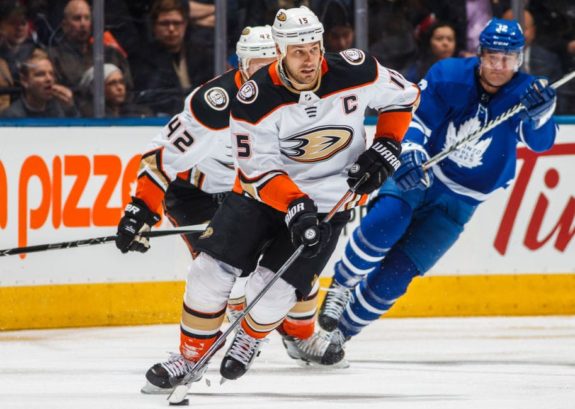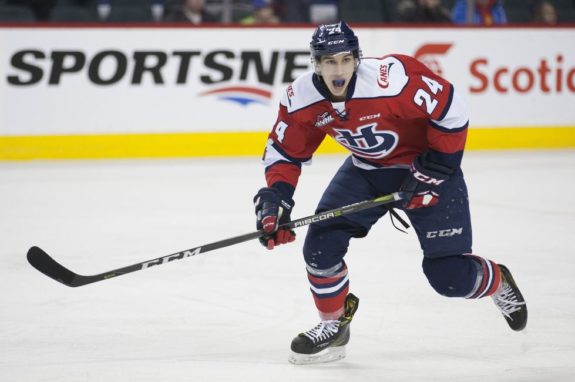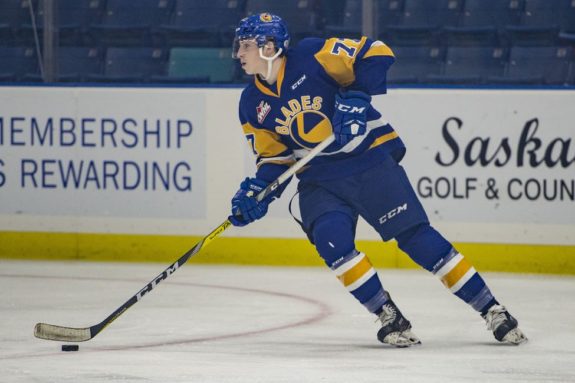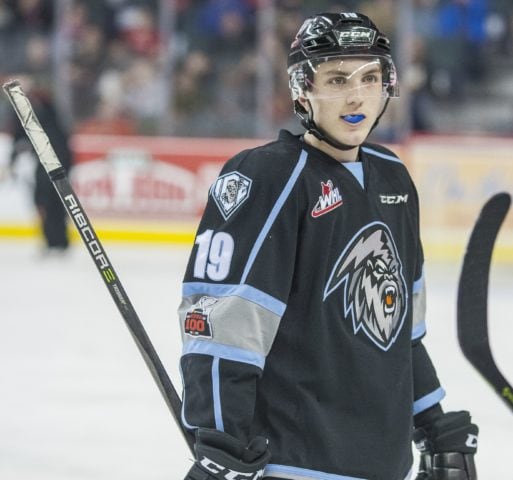The NHL Draft is just a few days away, and the Anaheim Ducks hold the highest pick they’ve had (No. 9) since 2012. The pick comes at an interesting time for Anaheim. Coming off their worst season since 2011-12, they just hired Dallas Eakins as head coach and hope he will be around long enough to deploy the new assets they pick up at this and future drafts.
The Ducks have needs at center and defense, which they should address with their two picks in the first round. Here’s a look at three candidates for the Ducks’ first pick. (Stay tuned later this week for candidates the Ducks could take at No. 29)
It’s a Good Year to Need a Center
With Ryan Getzlaf approaching the end of his career and Ryan Kesler likely to end up on long term injured reserve for the rest of his career, the Ducks need to reload at the center position.

The 2019 NHL Entry Draft is deep at center. There is a chance that up to six centers could be selected in the top 10 picks. That’s only happened twice in the last decade, in 2011 (6) and 2016 (7).
After Jack Hughes and right winger Kaapo Kakko, there isn’t a lot of consensus among experts over who will go after them. Even within one outlet, there isn’t much agreement about who will go when, especially when it comes to players that might interest the Ducks.
In his most recent ranking, TSN’s Bob McKenzie listed centers Alex Turcotte at No. 4, Kirby Dach at No. 5, Dylan Cozens at No. 6 and Peyton Krebs at No. 10. His colleague Craig Button listed Krebs at No. 8, Turcotte at No. 10, Dach at No. 12 and Cozens at No. 14. The top of this year’s draft is as unpredictable as any before it.
Cozens Comes to Town?
If Cozens is available, the Ducks would do well to draft him. Our THW experts project he will be draftedsomewhere between No. 4 and No. 8, but he would be great for the Ducks. If you’re talking about a Getzlaf replacement, Cozens fits the mold with his size and physicality.
He is not, however, a pass-first player, which is actually why I like him. According to draft experts, he’s got an excellent shot, great offensive instincts, and a body to impose his will on opponents. I love the idea of a big sniper on the Ducks, considering their offensive struggles.

There is some concern Cozens is playing the wrong position. Button raised questions over whether he would find more success as a center or winger when he spoke on NBC Sports Net Chicago’s “Hawks Talk” podcast:
“I think that he might be better suited as a winger receiving the puck where he can use his skating and use his size to get down the wing into openings where a better playmaking center can really bring out the best of Dylan.”
Though the Ducks should aim to draft a center, they shouldn’t worry about Cozens being better suited on the wing. They already have multiple players on their team and in their system like Troy Terry, Max Comtois and Rickard Rackell capable of playing multiple forward positions and switching a player from center to wing isn’t uncommon.
Could Cozens Be Ducks’ Draisaitl?
When it comes to NHL players Cozens compares to, I agree with our draft expert Ryan Pike, who compared him to Leon Draisaitl. They have similar size, Cozens is even taller and should add muscle, and he’s fast. He’s already got the scoring tools that Draisaitl has developed — Draisaitl reached the 50-goal plateau this season after being tabbed an elite play-maker heading into his draft year.
Though Cozens’ playmaking ability hasn’t created as much buzz as some of the other centers at the top of this draft, in the unlikely event he’s still available at No. 9, I would take him if I were the Ducks.
If Cozens can add some play-making ability to his scoring touch when he makes the NHL, he would be a real threat for the Ducks.
Ducks Draft Dach?
Kirby Dach is another player who draft experts say could go anywhere from No. 4 to No. 10. If I’m Murray and Cozens isn’t available, I’d draft Dach.
Dach is even bigger than Cozens, though experts say he hesitates to use his size as much. He’s also described as a pass-first player.
The part of his all-round game that is most attractive to me is his ability to turn pucks over. Dach excels at winning battles and turning pucks over on the forecheck, which is valuable.
A big issue for the Ducks in 2018-19, especially under former head coach Randy Carlyle, was the ineffectiveness of his traditional dump and chase strategy. The Ducks would dump the puck into the offensive zone, lose puck battles and immediately have to defend again.

Dach’s forechecking skill gives the Ducks a better ability to retrieve pucks and generate more puck possession. That’s a vital need considering the Ducks were the NHL’s fifth-worst puck-possession team in Corsi-for % at 47.24 during the 2018-19 season.
If you aren’t a fan of fancy stats, the eye test works too. The Ducks were an atrocious offensive squad for most of the season and part of generating offense is having the puck. Part of having the puck is forcing turnovers. Dach, by all indications, is good at that.
Dach Would Increase Ducks’ Flexibility
Dach would give the Ducks some flexibility. With Eakins at the helm, the team will likely attempt more controlled zone entries and create more off the rush. Having a player like Dach could theoretically help them to do that in the future, and also more successfully dump and chase when they need to.
Dach won’t be strictly a high-end, create-off-the rush player who must be allowed to play with other top-6 forwards. Dach’s forechecking ability would allow the Ducks to insert him into the bottom six if they need to, where it’s more likely that they will employ a dump-and-chase strategy.
You would hope a player drafted in the top 10 won’t spend his career as a third or fourth-line center, but that doesn’t mean he can’t start there to gain some NHL experience and add depth until he’s more confident.
Krebs’ Injury Shouldn’t Dissuade Ducks
In our The Hockey Writers mock draft, my pretend Ducks’ luck played out much like the real Ducks’ luck did this season. Cozens and Dach were not available so I went with Krebs. Less than 12 hours after I selected Krebs at No. 9, Cory Pronman of The Athletic tweeted that he had torn his Achilles tendon in an offseason workout.
Typical.
It’s a scary injury, especially for a talented skater like Krebs, but Achilles injuries aren’t a career death sentence. However, it may slow down his development and the time it takes him to reach the NHL.
In a 2017 study published in the American Journal of Sports Medicine, doctors from the New York Presbyterian Hospital studied professional athletes from the four major American sports, including the NHL who had suffered “a primary complete Achilles tendon rupture treated surgically.” They came to these conclusions:
“An Achilles tendon rupture is a devastating injury that prevents RTP (return to play) for 30.6% of professional players. Athletes who do return play in fewer games, have less play time and perform at a lower level than their pre-injury status. However, these functional deficits are seen only at one year after surgery compared with matched controls, such that players who return to play can expect to perform at a level commensurate with uninjured controls two years postoperatively.”
It sounds like Krebs’ Achilles is only partially torn, so his injury might not be as unpalatable to NHL teams as it first seemed. It may also mean he’s more likely to be available to the Ducks at No. 9.
All the medical talk aside, why would the Ducks want Krebs?
Krebs Benefits
According to our own draft experts, Krebs could be the total package with excellent skating and play-making skills, hockey sense, defensive responsibility and a willingness to be physical.
He’s played on a lousy team, the Western Hockey League’s Kootenay (now Winnipeg) Ice but has put up points. It’s hard to tell how much of a project he will be considering he’s probably being held down playing on a noncompetitive team.

The Ducks’ anemic offense last season is likely to improve as long as Terry, Sam Steel, Comtois, and Max Jones continue to develop at the NHL level, but they still need help. I like Krebs’ play-making ability and his potential to help the Ducks’ power play.
From Defense to Offense
His speed will help Anaheim transition to a faster game, something they’ve struggled with. His willingness to backcheck and his ability to read plays in the defensive zone will theoretically help gain turnovers and increase puck possession, like Dach.
In his assessment of Krebs, Vince Gibbons of McKeen’s Hockey wrote:
“Krebs’ hasn’t been sheltered at all this season and his defensive game has evolved because of it. His vision and speed able him to read other players movement and then to get to a point on the ice before them. He breaks up passes, lifts sticks and strips pucks as well as anyone in his age group.”
Even with his injury, Krebs would be a smart pick for general manager Bob Murray and the Ducks.
No matter who the Ducks select in the 2018-19 Draft, the depth of this crop of prospects will undoubtedly bring added value to an Anaheim team that has developed a stable of talented young players. It may take another season or two, but under the experienced eye of Martin Madden as director of professional and amateur scouting, Murray and Eakins, the future is looking bright in Anaheim.
All stats from naturalstattrick.com